Soutik Biswas,India correspondent, @soutikBBC
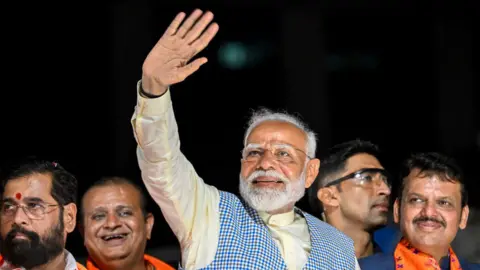 AFP
AFPIndian PM Narendra Modi is on course for a third consecutive term in a much tighter general election than anticipated.
His Bharatiya Janata Party (BJP) looks set to fall short of a majority and is leading narrowly in the 543-seat parliament, below the required 272 seats. However, its coalition partners have gained additional seats.
The results are a personal blow to Mr Modi, who has always secured majorities in elections as both chief minister of Gujarat state and India’s prime minister, and dominated the country’s politics for a decade.
The verdict marks a surprising revival for the Congress Party-led INDIA opposition alliance, defying earlier predictions of its decline, and sharply diverging from both exit polls and pre-election surveys.
More than 640 million people voted in a marathon seven-week election, hailed as a “world record” by election authorities. Nearly half of the voters were women.
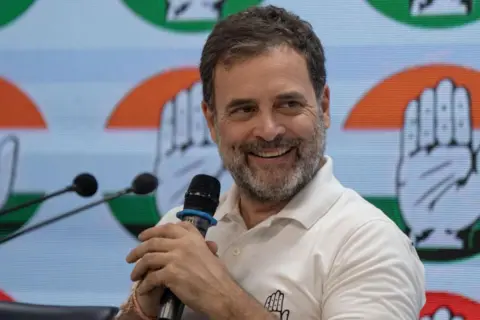 Getty Images
Getty ImagesMany world leaders have crawled across the finishing line in their third term elections and Mr Modi is no exception. The BJP remains India’s single largest party by seats, and if Mr Modi secures a third term with his allies, the prime minister matches the record of Jawaharlal Nehru, India’s first premier.
But the significant loss of seats for his party – more than 50 – dims the allure of a third term, especially given Mr Modi’s campaign targeting 400 coalition seats, making anything less seem like an under-achievement.
This has led to jubilation in the Congress camp and some despair in BJP quarters. Despite the BJP emerging as the single largest party, the burden of hype and expectations has left many of their supporters disheartened.
Mr Modi’s supporters believe securing a third term can be attributed to several factors: a record of stable governance, the appeal of continuity, efficient welfare programmes, and the perception that he has enhanced India’s global image.
To his Hindu nationalist base, Mr Modi delivered on key manifesto promises: revoking the autonomy of Indian-administered Kashmir, building the Ram temple in Ayodhya and implementing a controversial citizenship law. Many BJP-ruled states have implemented laws tightening regulations on interfaith marriages.
 AFP
AFPThe BJP’s significant drop in seats may be linked to joblessness, rising prices, growing inequality and a controversial army recruitment reform, among other things. Mr Modi’s harsh and divisive campaign, particularly targeting Muslims, could also have alienated voters in some regions.
His ambitious slogan “Ab ki baar, 400 paar,” aiming for more than 400 seats for his NDA alliance, may have backfired, with such a massive majority raising fears of constitutional changes among the poor.
Mr Modi’s party faced its largest setback in Uttar Pradesh (UP), a state larger than the United Kingdom and three times as populous. With 80 parliamentary seats, UP holds significant sway in national politics – many consider it the gateway to Delhi. Both Mr Modi and Rahul Gandhi hold seats there.
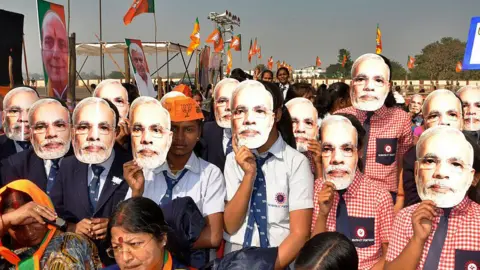 AFP
AFPSo what are the main takeaways of this election?
A dent of Brand Modi
Mr Modi’s popularity has been also attributed to his mastery of branding, transforming routine events into spectacles and astute messaging. A weak opposition and a largely friendly media also helped him build his brand.
The election results show that Brand Modi has lost some of its shine, indicating that even Mr Modi is susceptible to anti-incumbency. In other words, he is not as invincible as many of his supporters believed. This offers renewed hope to the opposition.
A return to coalition politics
India has a history of chaotic coalition governments, although some in the early 1990s and 2000s played a significant role in implementing economic reforms.
If the BJP forms the government, it will be dependent on allies and will need to adopt a more consultative and deliberative approach.
This dependency makes it vulnerable to collapse if allies feel neglected. The party, once perceived as all-powerful, is now reliant on allies, unlike in 2014 and 2019.
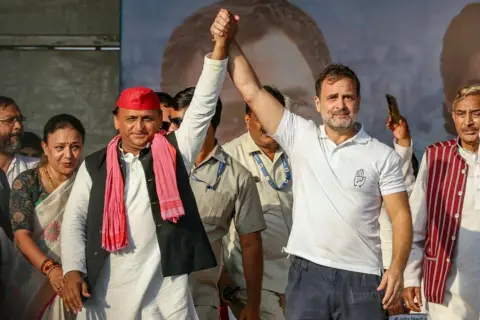 AFP
AFPA jolt to the dominant BJP
Mr Modi’s uninterrupted decade-long reign at the top has underscored India’s embrace of what some political scientists term the one-party dominant system.
This has five key traits: a charismatic leader, unrivaled control over resources and communication, unmatched organisational machinery, and an opposition in disarray. Shrinking freedoms also characterise a one-party dominant system.
Mr Modi’s BJP is not the first party to dominate Indian politics. For many years after Independence the Congress ruled without a break. Tuesday’s result has restored India to what many consider “normal politics”, with a range of parties sharing and competing for power.
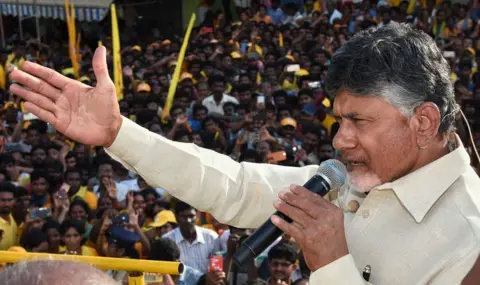 Getty Images
Getty ImagesA resurgent opposition
The results will energise the much-criticised Congress-led opposition.
In February, the diverse coalition known as INDIA, short for Indian National Developmental Inclusive Alliance, faced turmoil when one of its key leaders, Nitish Kumar, exited – only to later rejoin the BJP.
But led by Rahul Gandhi, the opposition ran a spirited campaign and narrowed the gap, in the face of a partisan media and despite fewer resources.
There is more hope for them ahead. The BJP holds about a third of India’s 4,000- plus state assembly seats and has lost to regional parties before. Over the next 14 months, five states are set for elections – all could be keenly contested.
With contests in Maharashtra, Jharkhand, and Haryana this year, the BJP could face substantial competition. Delhi’s upcoming election may pose challenges, while Bihar in October presents a regional hurdle.
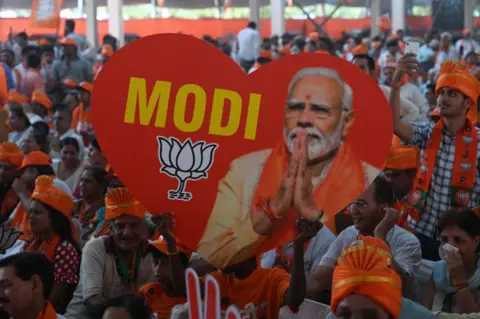 Getty Images
Getty ImagesSo what could a potential third term for Mr Modi mean?
India needs much more work and some healing.
The economy, fueled by government spending, is on the upswing. Yet inequality is rising. Private investment and consumption must increase, and the poor and the middle class will need more money in their pockets to spend more.
That will not happen if there are not enough jobs. In a country bristling with ambition and frustration, younger voters are likely drift from the BJP – around two-fifths of India’s billion-plus people are under 25.
Mr Modi has drawn criticism for marginalising Muslims, India’s largest minority, who have borne the brunt of violence. His government faces accusations of stifling dissent, with leading opposition figures jailed on what they say are trumped-up charges.
But third terms have often proved to be rocky for many leaders, with unforeseen and unpredictable events blowing governments and their plans off course.





















Discussion about this post